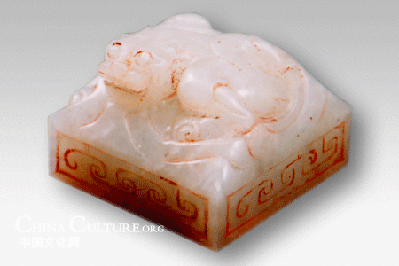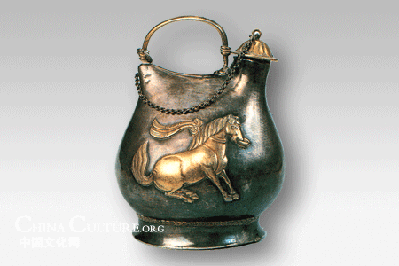4. Incense Burner

Age: Han Dynasty (206BC-220AD)
Height:58cm; Burner Diameter:9cm; Base Diameter:13.3cm
Unearthed in 1981 from Douma Village, Xingping County, Shaanxi Province
This incense burner falls into the category of Boshanlu, a type of incense burner popular during the Han Dynasty. Boshanlu are incense burners in the form of mountain peaks rising over waves, symbolizing the abode of the Immortals. Inlaid with gold, this incense burner is a rare artifact with fascinating craftsmanship. Nine dragons carved on this burner display imperial power, with the number “nine” and dragons symbolizing the imperial family in traditional Chinese culture. The handle was in the shape of bamboo and was divided into five sections. On the outer edge of the burner, some inscriptions indicate that this burner was the gift Emperor Han Wudi gave to his sister Princess Yangxin and her husband General Weiqing.
5. The Empress’ Jade Seal

Age:Han Dynasty
Height:2 cm; Side Length:2.8 cm
Unearthed in 1968 at Liangjiagou, Xianyang, Shaanxi Province
This seal was made of He Tian jade from Xinjiang Uygur Autonomous Region. With a monster-shaped protrusion as a knob, the seal was inscribed with four characters ‘Huang Hou Zhi Xi’, which means it is an empress’ seal. It was unearthed just 1 km from Changling ,the mausoleum of Emperor Gaozu (named Liu Bang) and his wife (named Lye Zhi ). Therefore, it may have been used by Empress Lye Zhi .The jade seal is one of the most important seals ever to have been found.
6. Silver Pot with Cup-in-Mouth Dancing Horse Design

Age:Tang Dynasty (618-907)
Height:14.3 cm
Unearthed in 1970 from hejiacun, Xi’an
This pot has a decorative design of a horse with a ribbon around its neck and its tail flowing in the air. The horse holds a drinking cup in its mouth -- an allusion to poetry from the period describing the "dancing horses." Dancing horses often performed at court The patterns confirm the historical account that Emperor Taizong trained fine horses that danced to music. It is said that during the performance, they were given wine to drink in cups that they picked up and tilted into their mouths. They used to dance to celebrate Emperor Tangxuanzong’s birthday. The grand scenes of the emperor's birthday celebration party shown on the pot expresses Chinese culture as well as something of an exotic atmosphere.
